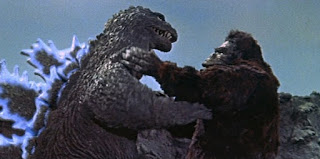THE #9 RATINGS SYSTEM
9: Classic
8: Excellent
7: Very Good
6: Good (Above Average)
5: Average
4: Bad (Below Average)
3: Very Bad
2: Bordering on Nauseating
1: Excruciatingly Awful
The center of this list is just that: it centers everything that goes on in the system. My assumption is that the bulk of films that are released are not actually good or even bad, but simply average. Average films for a populace that accepts mediocrity as a critical vanguard. It is where Chris Columbus films go to die, it is where 18-kid family movies can rest in pieces, and it is where the bulk of Julia Roberts' and Sandra Bullock's careers can gather dust for all eternity. (I say "the bulk" of their careers, for they do have good films on their resumes.) The worst place that a film can land on this list is not at #1, "Excruciatingly Awful" No, it is its being relegated to the middle of this list, the merely "Average" slot, for my next assumption is that if a film is actually bad, then there must be a certain level of interest in it. Not so with the average films; to me, the worst cinematic crime that a filmmaker can perpetrate on his audience is lulling them into numbing acceptance of subpar material. Hey, Hamlet, are you drilling for oil? No? Then why don't you stop boring?
That leaves 4 slots up, and 4 slots down; up for excellence, down for putrescence. On the low end of the scale, it might shock you to find out that a certain renowned "Bad Film" does not reside at the bottom of my ratings well. The truth of the matter is that Plan 9 From Outer Space is not the Worst Film of All Time. There are films of far greater incompetence out there, and despite what you may have been lead to believe over the years, Ed Wood did possess a certain rebel ingenuity in producing his pictures. They may seem haphazardly made, and they were, often on the fly, and it is the sheer gall and chutzpah that he used which comprise the reasons why I actually admire him. More filmmakers should be possessed of the sheer drive that he had to complete his poverty row affairs. So, Plan 9 does not get a 1 on my list; I actually rate it about a 3. It is a very bad film, but it is quite endearing in its naïveté, and there are far worse films to have to endure. (Manos: Hands of Fate is certainly one of them. I fully agree with MST3K's and EW's assessments.)
As for the good ratings slots, they are easy to figure out, but I must say that I have an awfully hard time letting a film make the jump to "Classic" status. Even films generally considered to be classics will often get short shrift at my hands, and even many films that I number amongst my favorites do not end up in that hallowed category.
I am still working out some of the details of the list, and am still undergoing a slow and monotonous renovation of my ratings on IMDB to fit its parameters. Anytime I see a picture anew, I reevaluate my rating to make sure that it is properly placed, and as I continue to list films on my sporadically posted Recently Rated Movies feature, all of the detailed films will have been changed or added to IMDB prior to posting (you may access my IMDB ratings but clicking on the link on the side of this page).
I had previously announced two of my Movie Attendance Mottos in a post over two months ago, and mentioned them only at that time because they pertained to the subject at hand. The third had not come into play with that subject. It is now time that I laid out all three together:
The second rule means that I won't sneak out of showings of films at odd times when my friends are going, even if I don't really want to see a certain film. It's the "Well, why the hell not?" rule. I take a certain measure of pride in following through on this rule, and I have to be truly in pain to not go. (Sometimes, in the case of the first time I saw the modern version of The Mummy, I was in intense pain but jammed a bunch of prescribed painkillers down my throat and went anyway. When I saw the picture again a couple months later, I realized that I had been lucky to have slept through most of it the first time, and longed to have some of those painkillers back in my pocket.)
The third and last rule stemmed from a life spent ragging on my co-workers' choices of reading material: Danielle Steel, Harlequin romances, Harold Robbins, Nora Roberts, The Destroyer and Executioner serials, Patrick MacManus' outdoors larf-fests, and V.C. Andrews' (or rather, her ghostwriters') inexplicably popular incest novels. I read examples, sometimes more than one, of all these series or writers in a quest to ascertain exactly why they were all so popular, and especially with people that I had to deal with on a daily basis. A little research helped me understand the earthlings a little better, and supplied me with ample ammunition for future attacks on character and taste (if needed). (For the record, Nora Roberts is a pretty damn good writer, MacManus is intermittently amusing, and the Destroyer novels were more fun than I like to admit to having had reading them. The rest can suck it.) I eventually found my attacking the filmic choices of others to run counter to what I applied to literature, so I simply adapted that rule and added it to my list.
And there you have it...
As for the good ratings slots, they are easy to figure out, but I must say that I have an awfully hard time letting a film make the jump to "Classic" status. Even films generally considered to be classics will often get short shrift at my hands, and even many films that I number amongst my favorites do not end up in that hallowed category.
I am still working out some of the details of the list, and am still undergoing a slow and monotonous renovation of my ratings on IMDB to fit its parameters. Anytime I see a picture anew, I reevaluate my rating to make sure that it is properly placed, and as I continue to list films on my sporadically posted Recently Rated Movies feature, all of the detailed films will have been changed or added to IMDB prior to posting (you may access my IMDB ratings but clicking on the link on the side of this page).
THE MOVIE ATTENDANCE MOTTOS
1. I Will See Any Movie At Least Once.2. I Will See Any Movie at Any Time (Barring Previous Engagement or Deathly Illness).3. I Must See A Film First Before Critiquing It.Pretty basic summation of what keeps my movie-watching engine running. The first movie mainly makes me watch any movie that I am confronted with, whether buddies want to check out the latest action flick, or a niece wants me to watch a Hilary Duff movie with her. Rather than barring my eyes from different genres, styles, and actors (whether I actually have an interest in their work or not), it keeps things fresh and keeps me up on new trends in the cinema. It also means that I am more apt to check out that most likely crappy film that I pass on Sci-Fi or USA, but the truth is, you never know what you will discover until you actually check something out. Especially things off of your well-beaten path.
The second rule means that I won't sneak out of showings of films at odd times when my friends are going, even if I don't really want to see a certain film. It's the "Well, why the hell not?" rule. I take a certain measure of pride in following through on this rule, and I have to be truly in pain to not go. (Sometimes, in the case of the first time I saw the modern version of The Mummy, I was in intense pain but jammed a bunch of prescribed painkillers down my throat and went anyway. When I saw the picture again a couple months later, I realized that I had been lucky to have slept through most of it the first time, and longed to have some of those painkillers back in my pocket.)
The third and last rule stemmed from a life spent ragging on my co-workers' choices of reading material: Danielle Steel, Harlequin romances, Harold Robbins, Nora Roberts, The Destroyer and Executioner serials, Patrick MacManus' outdoors larf-fests, and V.C. Andrews' (or rather, her ghostwriters') inexplicably popular incest novels. I read examples, sometimes more than one, of all these series or writers in a quest to ascertain exactly why they were all so popular, and especially with people that I had to deal with on a daily basis. A little research helped me understand the earthlings a little better, and supplied me with ample ammunition for future attacks on character and taste (if needed). (For the record, Nora Roberts is a pretty damn good writer, MacManus is intermittently amusing, and the Destroyer novels were more fun than I like to admit to having had reading them. The rest can suck it.) I eventually found my attacking the filmic choices of others to run counter to what I applied to literature, so I simply adapted that rule and added it to my list.
And there you have it...
































